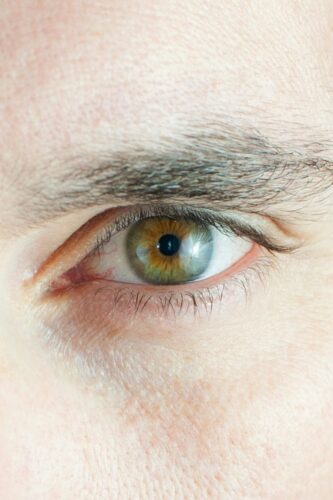Staring Meaning: Unlocking the Secrets of Intense Gazes

However, one of the behaviors that is understandably a bit strange, and perhaps even somewhat creepy, relates to autism and staring.
So, what is the staring meaning? While intense staring rightfully draws attention and sometimes causes discomfort in social situations, it’s usually not something that is being done deliberately.
Often, autism and staring that involves a prolonged, fixed gaze is somewhat common, even though the intent is often misunderstood by those unfamiliar with ASD.
I’m guilty of it as well, although the furthest thing from my mind when engaging in intense staring is to creep someone out.
Instead, the behavior occurs when I’m not paying attention to my actions and just watching someone or something with an innate curiosity while being unaware that I’m fixating in a way that is considered socially inappropriate.
When I catch myself doing it, I can easily stop staring as a conscious result. Then, I try and stare at something like a wall or something inanimate so I can let my mind wander without bothering anyone. For me, it’s as simple as that, although I realize not everyone can consciously shift gears like that quickly.
Autism and Staring: What Does It Look Like?
Intense staring in individuals with autism can manifest in various ways:
Prolonged eye contact: Some individuals may maintain eye contact for much longer than is typically comfortable in social situations.
Fixed gaze on objects: An autistic person might stare intently at a particular object, seemingly oblivious to their surroundings.
Staring at a specific body part: Instead of making eye contact, they might focus on another part of a person’s face or body.
Peripheral gazing: Some individuals may appear to be looking past or through a person while actually observing them from their peripheral vision.
Sudden, intense looks: Quick, piercing glances that can feel very intense to the recipient.

Apparently, I’m far from alone with staring, because Reddit users with autism have indicated that they often stare for similar reasons. akiraMiel indicated they stare, saying “kinda yes but I often zone out when doing it so I’m not actually looking at them.” Alienfireshroom agreed, saying: “I have to snap myself out of it sometimes. I just find people interesting to watch.”
Another user, who said they were aware of their actions, knows it makes people uncomfortable so tries to limit the behavior.
They said: “I force myself to stop staring because I know it makes people feel uncomfortable, but I really love to look at people, what they do, how are they dressed, what are the characteristics of their face. I also really like to stare into open windows and have a glance of another house, imaging the life people live there… it feels so magical. Anyway, I try my best to not be creepy.”
Staring Meaning: Explaining Autism and Staring
Sensory Processing Differences
Many individuals with autism process sensory information differently than neurotypical individuals. This includes visual information. Intense staring may be a way for them to better understand and process what they’re seeing.
The human brain typically filters out a significant amount of sensory information to prevent overwhelm. However, many autistic individuals experience sensory information more intensely and may not filter it in the same way. This can result in a need to focus intently on visual stimuli to make sense of it.
LEARN MORE: Sensory Integration Dysfunction? A Sensory Diet Can Change Your Life
Difficulty with Typical Eye Contact
While some autistic individuals may engage in prolonged eye contact, others find it uncomfortable or overwhelming. In these cases, intense staring at a specific point (like someone’s forehead, an object in the room, or a particular feature) may be a coping mechanism. It allows them to orient themselves toward the person they’re interacting with without the discomfort of direct eye contact.
RELATED: Eye Contact Avoidance and 8 Best Ways to See Eye to Eye
Fascination with Details
Many individuals with autism have a heightened ability to notice and focus on small details that others might overlook. This attention to detail can be a significant strength in many areas, but it can also manifest as intense staring when something captures their interest. They might be examining the pattern on someone’s shirt, the way light reflects off a surface, or any number of visual details that fascinate them.
RELATED: Hyperintense Focus: Is Looping in Autism a Cause for Concern?
Non-verbal Communication
For some autistic individuals, especially those who are non-speaking or have limited verbal communication, intense staring may be an attempt at non-verbal communication. It could indicate interest, a desire to interact, or an effort to understand the other person’s emotional state or intentions.
LEARN MORE: Exploring the Power of Nonverbal Autism
Difficulty Shifting Attention
Executive functioning challenges are common in autism, and this includes difficulty with attention shifting. Once an autistic person’s attention is captured by something, they may find it hard to disengage and shift their focus elsewhere. This can result in prolonged staring that isn’t intentional but rather a result of cognitive processing differences.
READ MORE: Why Having Brains on Fire Sparks Innovation
Emotional Regulation
Some researchers suggest that intense staring might be a self-soothing behavior for some autistic individuals. In overwhelming or stressful situations, focusing intently on a single visual point might help them regulate their emotional state.
RELATED: Helpful Self-Regulation Tips for Keeping Calm and Carrying On
Social Cue Processing
Understanding and interpreting social cues can be challenging for many people with autism. Intense staring might be an attempt to gather more information about social situations or to try to decipher the subtle nonverbal cues that others are exhibiting.
LEARN MORE: Autism Social Skills: Inferencing and Body Language Hurdles to Overcome
The Impact of Intense Staring on Social Interactions

Misinterpretation: Neurotypical individuals might misinterpret intense staring as aggression, romantic interest, or rudeness, leading to social confusion.
Discomfort: Prolonged eye contact or staring can make some people feel uncomfortable or self-conscious.
Communication barriers: If an autistic person is intensely focusing on a visual detail, they might miss other important aspects of communication, such as tone of voice or body language.
Stigma: Lack of understanding about this behavior can contribute to stigma and social isolation for individuals with autism.
Positive engagement: In some cases, intense staring might indicate deep interest or engagement, which can lead to meaningful interactions when understood correctly.
Strategies for Understanding Autism and Staring
For individuals interacting with someone who exhibits intense staring:
Educate yourself: Learning about autism and common behaviors such as the staring meaning can increase understanding and patience.
Don’t take it personally: Remember that intense staring is not typically meant to be rude or aggressive.
Continue communication: If you’re in a conversation, continue speaking normally. The person may be listening even if their gaze suggests otherwise.
Provide alternative focus points: If you’re uncomfortable with the staring, you can provide an object or point of focus for the person to look at while you interact.
Use clear, direct communication: If the staring is causing discomfort, it’s okay to gently and clearly express this and suggest an alternative (e.g., “I feel a bit uncomfortable with eye contact. Would you mind if we both looked at this interesting painting while we talk?”)
Helping Autistics to Stop Staring That is Considered Inappropriate
While the behavior may be hard to stop, especially when the person who is engaging in intense staring is unaware of the discomfort it causes others or even that they are doing it, there are strategies to consider to minimize it.
Tips for Teachers, Parents, Caregivers
Teach social skills: While accepting and understanding the behavior, you can also work on teaching alternative social skills when appropriate.
Create a supportive environment: Educate peers, family members, and others about autism and behaviors like intense staring to foster acceptance.
Explore the function: Try to understand what purpose the intense staring might serve for the individual. Is it calming? Is it a way of showing interest? Understanding the function can help in developing supportive strategies.
Provide sensory supports: If intense staring is related to sensory processing, providing other sensory tools or supports might help.
Encourage self-advocacy: Help the autistic individual understand their behavior and develop ways to communicate their needs to others.
Tips for individuals with autism who engage in intense staring
Self-awareness: Understanding your tendencies can help in developing coping strategies or explanations for others when needed.
Develop alternatives: If you’re comfortable doing so, you might practice alternative behaviors for showing interest or engagement in social situations.
Use communication tools: Consider using verbal explanations or cards that explain your behavior to others if you feel it would be helpful.
Self-advocacy: Feel empowered to explain your needs and preferences to others. It’s okay to tell people if you’re more comfortable not making eye contact, for example.
The Importance of Neurodiversity Acceptance
In discussing behaviors like autism and staring, it’s crucial to frame the conversation within the context of neurodiversity acceptance. Neurodiversity is the concept that neurological differences, including autism, are a natural part of human variation rather than deficits to be cured.
Accepting neurodiversity means:
- Recognizing the strengths and unique perspectives that come with different neurotypes.
- Adapting environments and expectations to be inclusive of diverse neurological makeups.
- Focusing on support and accommodation rather than trying to change fundamental aspects of how a person’s brain works.
- Challenging societal norms about what constitutes “appropriate” behavior in social interactions.
In the case of intense staring, a neurodiversity-affirming approach involves understanding the behavior, recognizing its potential benefits and challenges, and working collaboratively to create inclusive social environments.
Research and Scientific Perspectives
While anecdotal evidence and clinical observations have long noted intense staring as a common behavior in autism, scientific research in this area is still evolving. Several studies have attempted to quantify and understand this phenomenon:
Eye-tracking studies: Researchers have used eye-tracking technology to analyze how individuals with autism visually process faces and scenes. Some studies have found that autistic individuals tend to focus more on specific features or objects rather than following typical social scanning patterns.
Neuroimaging research: Brain imaging studies have suggested that individuals with autism may process visual information differently. For instance, some research has indicated heightened activation in brain areas associated with visual processing and reduced activation in areas linked to social cognition during face perception tasks.
Social attention studies: Research has explored how autistic individuals allocate their attention in social situations. These studies often find atypical patterns of social attention, which could manifest as intense staring in real-world scenarios.
It’s important to note that research in this area is ongoing, and findings can be complex and sometimes contradictory. The heterogeneity of autism means that broad generalizations are challenging to make.
Learn more: 11 Hot Topics in Research
Intense Staring and Employment

Job interviews: The unusual eye contact patterns associated with autism, including intense staring, might impact first impressions in job interviews. This underscores the importance of autism awareness among employers and the potential benefits of alternative interview formats.
Customer-facing roles: In jobs that require frequent customer interaction, intense staring might be misinterpreted. However, with proper understanding and accommodation, the attention to detail often associated with this behavior could be an asset in many roles.
Workplace education: Companies can benefit from educating all employees about neurodiversity, including behaviors like intense staring, to create more inclusive work environments.
Strengths-based approach: The intense focus that manifests as staring can be a significant strength in roles that require attention to detail, such as quality control, proofreading, or data analysis.
RELATED: Neurodiversity in the Workplace and Finding Autistics Jobs
Technology and Intense Staring
Advancements in technology are opening up new avenues for understanding and addressing intense staring:
Virtual reality (VR) training: VR environments are being developed to help individuals with autism practice social skills, including appropriate gaze behaviors, in a safe and controlled setting.
Augmented reality (AR) tools: AR apps are being explored as a way to provide real-time social cues and feedback, which could help autistic individuals modulate their gaze in social situations if desired.
AI-powered analysis: Artificial intelligence is being used to analyze gaze patterns and provide personalized feedback and strategies for social interaction.
Assistive communication devices: For non-speaking autistic individuals, eye-gaze controlled communication devices can turn intense staring into a powerful communication tool.
READ MORE: Autism and AI – 7 Exciting Examples of Artificial Intelligence Support
Intense Staring in Children vs. Adults with Autism
The manifestation and impact of intense staring can differ between children and adults with autism. Consider:
Early intervention: In children, intense staring might be one of the early signs that lead to an autism diagnosis. Early recognition can facilitate timely intervention and support.
Developmental changes: Some individuals may develop strategies to modify their gaze as they grow older, while others may continue to exhibit intense staring into adulthood.
Social expectations: As social expectations become more complex in adolescence and adulthood, the impact of atypical gaze behaviors like intense staring may become more pronounced.
Self-awareness: Adults with autism may have a greater awareness of their staring behavior and its effects on others, which can lead to increased self-consciousness or the development of masking behaviors.
Intense staring is just one of many behaviors associated with autism spectrum disorder that can impact social interactions.
By deepening our understanding of why this behavior occurs and its potential meanings, we can foster more inclusive, accepting communities.
Other Common Autistic Behaviors
There are many behaviors associated with having autism. Keep in mind that everyone presents differently, which is why it is called a spectrum disorder. However, there are common autism behaviors. Learn more about them.
- Autism and Eye Rolling: Why It’s Odd, But Perfectly Okay
- Elopement: Why Wandering Off is a Behavioral Nightmare
- Indecisiveness and Autism: How These 6 Factors Challenge Decision-Making
- Being Real Without Offending Others is Autistic Challenge
- 10 Proven Techniques for Managing Autism and Sensory Issues
- Understanding Neurodiversity: Uprising of the Neurodivergent
- 5 Ingenious Ways for Creating Boundaries in a Relationship
- Autism and ADHD: Making Sense of the Overlap
- Autism Masking & Code Switching: How to Redefine Acceptance
- Autistic Stimming Behaviors: Why We Do and How It’s Important
- OCD and Autism: Could You Have One Condition or Both?
